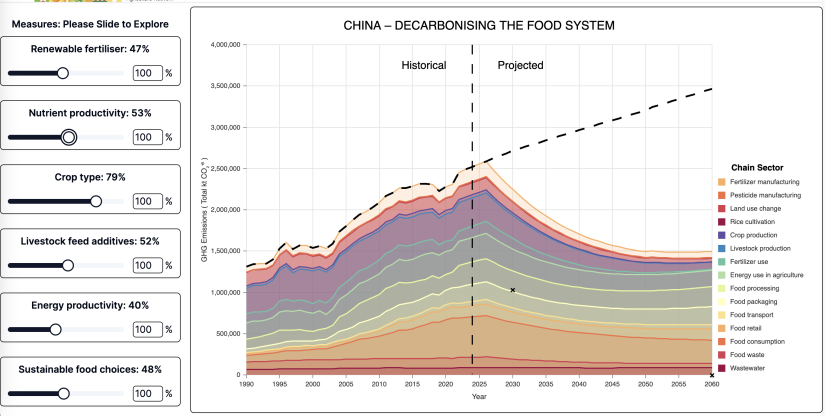ISF launches innovative project on climate change, phosphorus resilience and food systems in Shanghai.
A groundbreaking initiative at the nexus of climate change, phosphorus resilience and food security kicked off in May 2024, marking a significant stride towards sustainable agriculture and environmental stewardship.
Funded by the Australian Government’s National Foundation for Australia-China Relations (NFACR), the University of Technology Sydney’s Institute for Sustainable Futures (UTS-ISF) unveiled the Phosphorus and Climate Smart Agriculture Network (PACSAN) interactive model in a high-profile workshop attended by Chinese researchers and food sector stakeholders.
Since 2020, NFACR has supported over 150 Australian individuals and organisations through its annual grants program with more than AUD$25 million to develop, promote and strengthen understanding and constructive engagement between Australia and China at industry and community level.
PACSAN ultimately aims to assist Australia and China in simultaneously reducing greenhouse gas emissions to meet the Paris Agreement targets and ensuring phosphorus use supports food security while maintaining and improving water quality.
The project was officially launched in Shanghai, co-hosted by Shanghai University’s SILC business school, where distinguished researchers and stakeholders from the food sector gathered to share their expertise and to witness the UTS-ISF team unveil an interactive web-based model designed to meet net zero and phosphorus targets.
This model, showcased for the first time, underscores the necessity of a multifaceted approach to address both greenhouse gas emissions and phosphorus use effectively. While often not discussed in policy and research settings, the project demonstrates how the food system is a significant source of GHG emissions and the wide range of opportunities to address these. China’s food system contributes some 18% of the country’s total GHG emissions, while Australia’s food system contributes 40% of total emissions.
The PACSAN project also puts the spotlight on the understudied phosphorus story: the source of the essential element phosphorus for fertiliser use currently comes from finite, risky and increasingly expensive markets, which is also contributing to widespread global nutrient pollution. Distinguished PACSAN participant Professor Jianbo Shen from China Agricultural University, estimated in the workshop that China has up to CN¥ 550 billion worth of excess phosphorus locked up across the country’s agricultural soils, which could be tapped through innovative methods to simultaneously improve soil fertility, reduce future dependence on mined phosphate rock and improve water quality.

Screenshot of an interactive model scenario, indicating how sliding sustainability measures (left) can theoretically reduce future emissions in the Chinese food system.
What does this mean for climate change, phosphorus security and food security?

ISF Director Prof. Stuart White and PACSAN Project Director ISF Assoc. Prof. Dana Cordell chair expert panels in Shanghai, China.
Professor Stuart White, Director of ISF, highlighted the significance of the project, "To our knowledge, this is the first time two key planetary boundaries – carbon and phosphorus – have been modelled together to identify sustainable measures that can simultaneously address climate change, food security, and the environmental integrity of water."
Associate Professor Dana Cordell, Project Director for PACSAN, emphasised the implications of the initiative, "Other sectors like energy and transport have transition roadmaps for achieving net zero targets. But for the food and agriculture sector, there is little discussion or direction. The PACSAN initiative will contribute to the national dialogue in Australia and China on how the food system can contribute to net zero, while ensuring sustainable jobs, value chains, and land management"
The pair also emphasised that while there are agreed global and national targets for greenhouse gas emissions (Paris targets), there are no comparable agreed targets for phosphorus security, either to limit phosphorus entering rivers and lakes where it is causing nutrient pollution, or, to limit the amount of phosphate extracted from the earth for food production.

PACSAN China workshop participants in Shanghai.
Next steps for this initiative
The launch event in Shanghai is just the beginning. PACSAN has planned a series of activities, including a similar workshop in Australia and several online network meetings between the two countries. These efforts aim to identify and implement mutually beneficial strategies for meeting the project's ambitious goals.
Through the power of dialogue, collaboration and shared endeavour between members of the network, PACSAN hopes to influence the outcomes for the benefit of the planet and its people.
For more information on PACSAN and its upcoming activities, visit UTS PACSAN.
The National Foundation for Australia-China Relations’ next grants round will open soon. Updates are available through LinkedIn or by becoming a ‘Friend of the Foundation’ via www.australiachinafoundation.org.au/contact.

